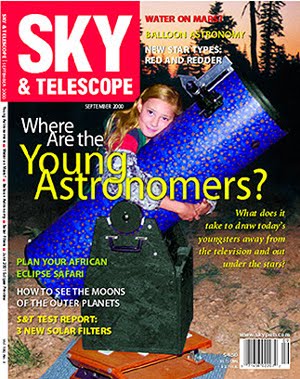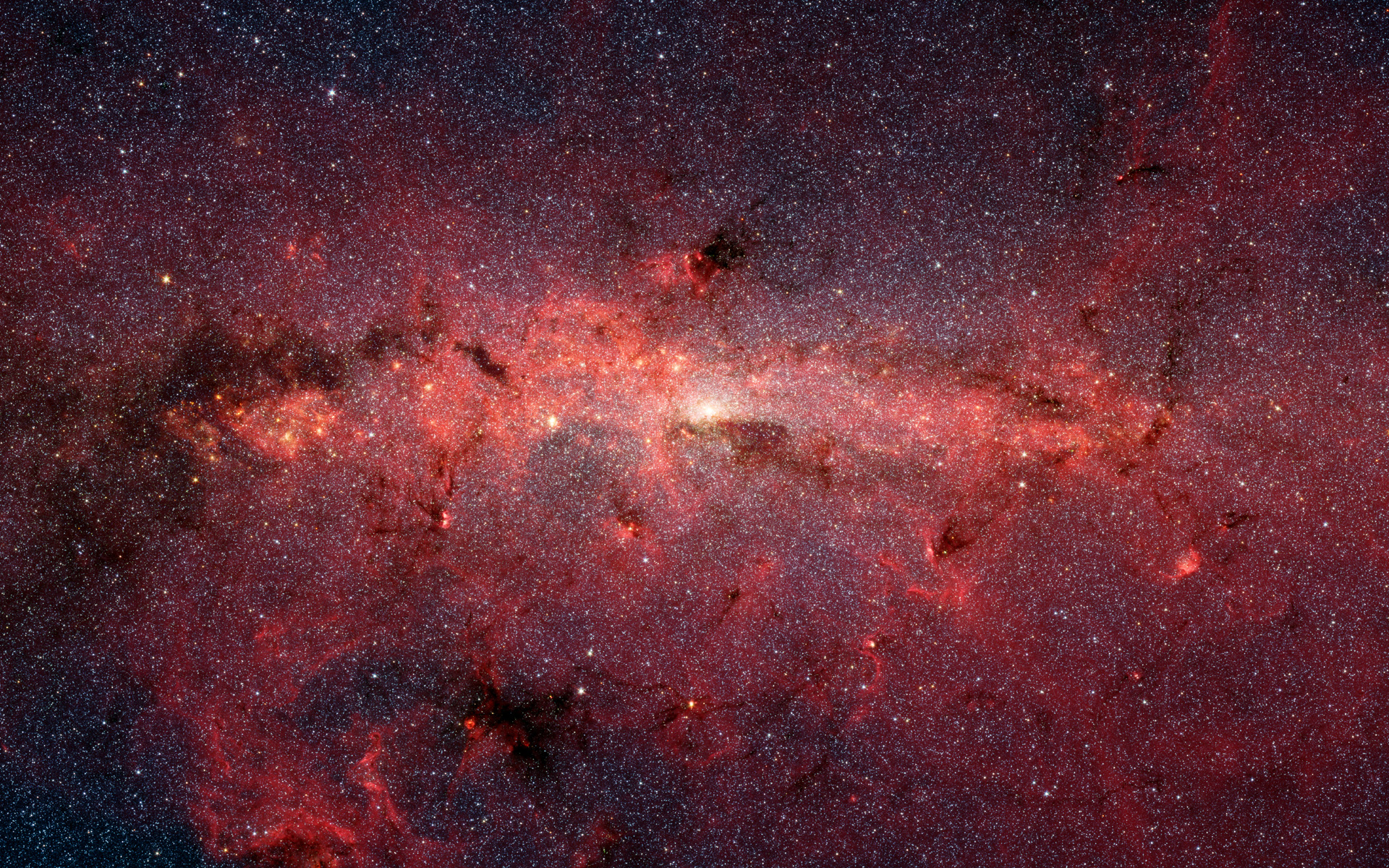Mimi (my 10 year old daughter) and I took two scopes out to the backyard this afternoon, to cool down while we ground a couple mirrors. My scope, a 10" Dob, my mirror, a 10". Mimi's scope (Jane's) 6" Dob. Mimi's mirror, a 6". After half an hour of getting mucky pushing glass, dinner was on the table. Shortly thereafter, darkness was upon us and out back we went, bundled against the frigid California January temperatures. Those of you from truly cold climates don't know how difficult it is for us real Californians to go out when the temp is below 50 F.
The bright thing was out again. And it was such a nice looking sky, otherwise. But, resigned to the fact that winter offers such rare sights as this clear a night, I decided to try out my Rukl mooney atlas and see what all the "fun" others claimed to have, was really about. Mimi and I began our search on page 9.
After a bit of explaining to her, Mimi helped me find the crater Marian, toward the northern limb. It was well lit, with its floor completely in shadow, its outer southern wall appearing to be split or in shadow. The entire area between Marian and the crater Sharp was in shadow, looking like a void in the surface of an otherwise bright terminator.
Mimi wanted to look at the Orion Nebula, but I told her it was a moon night. So, we moved the scopes toward Sinus Iridium, since it was so close. Mimi liked the name Bay or Rainbows, I think she'll remember that one. She thought the crescent shape was similar to that of a rainbow's arch, and thus, the name of the bay. Who knows? The bay was bathed in light, but the crater Bianchini at its southern border was partially in shadow. In fact, it was about half lit, the western wall showing lots of detail. I could see roughly the same markings as shown in Rukl page 10. At the northern edge of Bianchini, where it meets Sinus Iridium, there appeared to be a rift, a dark line forming a hard "edge" between the two lunar features.
Mimi, true to her dad's astronomical preferences, just could not hold out any longer. She asked for the 20 mm Meade and went after deep sky. She loved looking at even a washed out M42, and spent several more minutes hunting stars and trying to identify M objects. I took the 7 mm Meade she'd been using, and placed it in my 10".
The sky was very steady. I had no trouble holding fine features at this magnification (7mm in a 10" f/5.6, not bad for a dob). I moved back to page 9 and found Mons Delta Gruithuisen and Mons Gamma Gruithuisen. Both were very bright. The almost hurt my deep-sky eyes. But they were quite interesting to view, casting heavy shadows to their west. To their south was a broken crater, or, was it? It actually looked like another Mons that had broken down, perhaps at one time a third member of this Gruithuisen group. There is a small craterlet on Mons Gamma Gruithuisen that showed easily.
I was finding Rukl easy to follow after a bit of practice. I moved to the south and found the crater Delisle showing a nice zig-zag in its illuminated western wall. Some portions of Rima Delisle were visible leading over toward the double crater Heis. Heis is a small crater, and its secondary crater, imbedded in its wall, even smaller.
I was beginning to enjoy myself. The sludge of the day felt like it was sloughing off. The brisk air, Mexican coffee and ease of navigating the surface of this nearby object were all soothing. I thought I'd keep going.
I moved to page 10 and found Helicon and le Verrier almost entirely in light - Helicon has a small crater in the western inner wall.
Continuing northward along the terminator, I viewed Mons Delisle (Rukl page 19). It was casting a big shadow. There appeared to be a ridge, or "flow" running from Delisle northward to Diophanius, just as shown on Rukl. What a neat atlas! Without consulting the book, I found Louise, a tiny crater in a bright white small section between the two other craters. At the time though, I was unable to see Rima Diophanius. There were numerous small craters near Louise, not shown on Rukl, and then I though maybe I saw the Rima. I also felt I saw a crater in the northern wall of Diophanius not shown on Rukl.
One of the most stark and dramatic features on this southern portion of lunar landscape along the terminator was Montes Harbinger. These mountain peaks just jump out of the mostly flat surface. I wanted to view Prinz, a sunken crater just west, and its rimae complex running to its south, but it was in darkness. I looked back at the book for more clues of what to view.
Hey.... what is that big thing just east? The big hole? "The" crater. None other than Copernicus. I called Mimi over to look at it. Just as Rukl drew it. This massive hole in the moon was fully illuminated, except for a bit of shadow along the very eastern rim, perhaps an overhang, at about 19W and 9.9N. Awesome detail! Making it even more interesting was the photo on page 31 of Rukl, showing the crater floor in full shadow. What a play of dark and light this big plaster ball is!
By now I was fully into seeing what could be found. I moved to Keppler on page 31. The crater dominates the area. It has rubble fields all around it, and the shadows appeared to reveal a rima to its south, running southwest. The domes near Hortensius were very difficult to observe, but were "there" (barely), whereas the big dome by Millichius was very easy to see. I could not see Rima Milichius, but saw a dome just south of Milichius A about 1/3 the way toward Keppler B, right where the Rima should be. I refocussed and saw a hint of the rima north of the dome, or was it my imagination? Just then a cloud appeared over the moon in the eyepiece! Surprised, I looked up to see a jet had just zipped by leaving its con-trail right where I was observing. The only cloud in the sky.
Now, having seen a lunar occulation last night, I noticed a red star seemingly going to be occulted tonight, around the dark edge near Montes Harbinger. I decided move on and check back in a few minutes, thinking it would probably be about 15 before anything might happen.
I moved to Maestlin R - a beautiful walled plain with rima spreading 2 directions away to its north, right through, or seemingly, a peak. The rimae were obvious.
Also obvious was that the red star was now gone. Arrrrrrrhhhhh! Missed it by at most one minute!
That was it, somewhat taking the wind out of my sails, which is quite a task! I decided to try a few more objects before calling it a night. I moved to page 40 of Rukl, on to Latronne, a gorgeous arch looking like horns. the complex of Mare Humorum all around was in shadow, with just its back peaks jutting up into the light. I wonder how long one would need to watch to see their entire form illuminate? Even this hint of giant mountains was awe inspiring.
Finally, I moved on to what must be a favorite object of lunar observers. I started with Gassendi A, its wall in light, intersecting with Gassendi B and their big neighbor Gassendi. Gassendi had what appeared to be three peaks easily showing, brightly illuminated in the center, throwing big shadows. The western half of the crater floor was covered in rimae, showing very crisply... amazing detail. The eastern half of the crater floor seemed rather tame by comparison, with some rubble and a few rimae. The last thing I noticed was seemingly a sunken inner wall along the souther inner border of the crater.
I would have liked to stayed longer. I was almost blind, but it was fun.












No comments:
Post a Comment